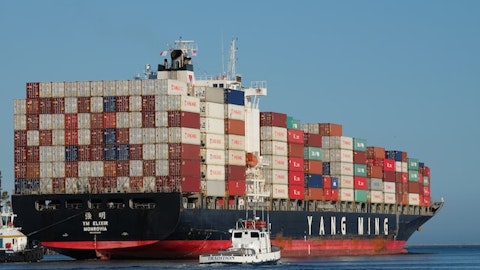Quad/Graphics, Inc. (NYSE:QUAD) Q4 2022 Earnings Call Transcript February 22, 2023
Operator: Good morning, ladies and gentlemen. Welcome to Quad’s Fourth Quarter Conference Call. During today’s call, all participants will be in a listen-only mode. A slide presentation accompanies today’s webcast and participants are invited to follow along, advancing slides themselves. To access the webcast, follow the instructions posted in the earnings release. Alternatively, you can access the slide presentation on the Investors section of Quad’s website under the Events and Recent Presentations link. Please also note today’s event is being recorded. At this time, I’d like to turn the conference call over to Katie Krebsbach, Quad’s Investor Relations Manager. Katie, please go ahead.
Katie Krebsbach: Thank you, operator, and good morning, everyone. With me today are Joel Quadracci, Quad’s Chairman, President and Chief Executive Officer; and Tony Staniak, Quad’s Chief Financial Officer. Joel will lead off today’s call with a business update, and Tony will follow with a summary of Quad’s fourth quarter and full year 2022 financial results, followed by Q&A. I would like to remind everyone that this call is being webcast and forward-looking statements are subject to safe harbor provisions as outlined in our quarterly news release and in today’s slide presentation, Slide 2. Quad’s financial results are prepared in accordance with generally accepted accounting principles. However, this presentation also contains non-GAAP financial measures, including adjusted EBITDA, adjusted EBITDA margin, adjusted diluted earnings per share, free cash flow, net debt and debt leverage ratio.
We have included in the slide presentation reconciliations of these non-GAAP financial measures to the financial measures. Finally, a replay of the call and the slide presentation will be available on the Investors section of quad.com shortly after our call concludes today. I will now hand over the call to Joel.
Joel Quadracci: Thank you, Katie, and good morning, everyone. Beginning on Slide 3, I am pleased to report that we delivered strong 2022 results, meeting or exceeding our guidance across all metrics, including outperforming our top line guidance with an 11% increase in net sales when excluding divestitures. These results reflect increased sales in all our offerings, including increases in pricing to partially offset inflationary costs, print segment share gains from both new and existing clients, as well as continued growth in our agency solutions offerings and international locations. As far as earnings, we achieved adjusted EBITDA near the high end of our guidance range, ending the year with higher adjusted EBITDA than 2021 when excluding a nonrecurring $13 million property insurance gain.
We also continued to pay down debt in 2022 and have reduced net debt by $489 million or 47% over the past 3 years. We ended 2022 with a debt leverage ratio of 2.16x, beating our guidance of approximately 2.25x and achieving our lowest leverage level since 2018. By the end of 2023, we expect to have paid off $564 million in debt, which would be a 55% debt reduction since January 1, 2020. Throughout 2022, our team skillfully navigated many challenges including paper and supply chain disruptions, inflationary cost pressures and labor shortages and our efforts to mitigate these impacts included price increases to partially offset inflation. The most recent of these increases went into effect on January 1, 2023. While we continue to see growth in the agency solutions part of our business, led by our digital marketing agency, Rise Interactive, economic uncertainty has prompted some clients to take a more conservative approach to the start of the year and pull back on their near-term print advertising spend.
As always, we take a disciplined approach to managing all aspects of our business, treating all cost as variable and we’ll continue to align our cost structure to revenue opportunities. At the same time, we are aggressively pushing forward on our growth strategy as a marketing experience or MX company, servicing marketers’ needs from end to end. This includes an increased investment in our people, processes and technology, including enhancing our agency solutions offerings and bringing a board experienced business development professionals who can sell into our critical growth verticals of direct-to-consumer, financial services, healthcare, insurance and consumer packaged goods. Slide 4 shows how we continue to diversify our revenue into higher value and higher-margin offerings.
In 2022, we achieved net sales growth in all our offerings, including targeted print and international increasing as a percentage of our total net sales. Large scale print decreased as a percentage of total net sales due to expected organic declines that we were partially offset by segment share gains. The increase in our international locations was primarily driven by stronger sales in Latin America, especially in Mexico, a strategic extension of our U.S. platform. Turning to Slide 5. I’m pleased to share that we have strengthened and diversified our strategic leadership at the governance level with the recent appointment of Beth-Ann Eason to Quad’s Board of Directors. Beth-Ann has a deep background in advertising, marketing, publishing and digital transformation and understands firsthand the challenges facing our clients.
For example, while with Accenture, she’s led C-suite engagements for prominent brands as they evolved and transformed drawing on her widespread digital marketing and digital media experience. We look forward to leveraging Beth-Ann’s expertise to enhance our competitive position and drive continued revenue growth. Turning to Slide 6. We highlight our three key competitive advantages. Integrated marketing platform excellence, ongoing innovation and culture and social purpose. We continue to strategically invest in our integrated marketing platform, which includes all the resources our clients need to plan, create, deploy, measure and optimize their marketing efforts across all media channels, offline and online. This is a key differentiator for Quad.
We are able to reduce the complexities of working with multiple agency partners and vendors and increase the efficiency of marketing processes. We do this while maximizing the effectiveness of our clients’ marketing efforts through our ability to target and reach the right audiences, scale resources more efficiently while increasing speed to market, achieve better integration of offline and online channels, optimize media performance, of consistent consumer experiences and realize meaningful cost savings. A key aspect of our integrated marketing platform is dedicated on-site and near-site teams that serve as an extension of our clients’ internal marketing departments. We have more than 80 on-site locations at client companies where our employees fulfill traditional agency executional roles while also providing production efficiencies at scale for content creation, creative production and marketing deployment.
We also continue to strengthen relationships with innovative partners like Flowcode, the leading online — offline to online QR solution for building powerful connections and measurable conversions for brands and consumers. Earlier this month, in the lead-up to the Super Bowl and advertising’s biggest stage, Flowcode announced the launch of its omnichannel QR and data platform for global brands, agencies, sports and web 3 backed by existing strategic investors, including Quad. Scan the Flowcode on Slide 7 for more information on this announcement, including flow code solutions for enabling first-party connections with consumers across all branded touch points. Quad is proud to partner with Flowcode to advance the effectiveness of marketing products through first-party data that helps clients better identify audiences and their passions.
On Slide 8, we show how we recently expanded our relationship beyond traditional print media execution with Meijer, a leading regional retailer that operates more than 500 supercenters, neighborhood markets and grocery stores. Meijer was seeking a better way to manage its traditional and digital media spend. Our Quad Media team presented a comprehensive solution for integrated media planning and placement across all channels, including search engine optimization, social media, programmatic TV, radio, out-of-home and print. A key feature of our solution was our ability to offer advanced cross-channel performance management via our proprietary Connex technology. With Connex, Meijer is not only able to uncover performance trends by audience, creative product and location, but also identify specific growth opportunities and take immediate actions to accelerate media performance.
We are also leveraging our cloud-based software as a service or SaaS platform for managing workflow, which includes the ability to streamline personalization at scale across multiple media channels. We are pleased to have expanded our relationship with Meijer and its subsidiary Freshtime, drawing on the strength of our integrated marketing platform, innovative proprietary technology solutions and deep experience with an understanding of the retail grocery industry. Turning to Slide 9. We show how our commitment to ongoing innovation is driving business results for a large and complex national health insurance company with whom we have had a long-standing relationship for traditional media execution. This client needed a better way to create and execute nationally consistent and locally relevant provider and product marketing for new member acquisition.
We introduced an automated data-driven and scalable solution that also leverages our SaaS platform, connecting remote teams, streamlining marketing execution, including dynamic messaging, and optimizing media across all channels. Through this solution, we were able to help our client create consistently branded, customized advertisements with fewer touches and in a fraction of the time. In fact, they can now execute targeted marketing efforts in mere minutes versus weeks, allowing them to focus on more value-driven marketing efforts. We are proud to be their Agency of Record for their provider program and look forward to introducing them to media mix optimization, another one of our integrated marketing services. On Slide 10, we highlight our third competitive advantage in, commitment to culture and social purpose.
Our long-standing focus on creating a better way is a reflection of our maker culture in which employees not only envision solutions, but also create and execute them. This approach, a hallmark of our company for more than 50 years, inspires creativity in how we address environmental, social and governance matters. In 2022, we advanced multiple environmental and social commitments, including improving the representation among our U.S. employees and U.S. management team in both gender and race and ethnicity, incorporating diversity, equity and inclusion competencies into performance reviews for U.S. leaders, achieving an 18% increase in annual spend with diverse suppliers and partnering with clients to increase our certified paper usage to 80%.
To learn more about these and other commitments, you can access our 2022 ESG update on quad.com or scan the Flowcode on Slide 10 of today’s presentation. Before I turn over the call to Tony, I would like to thank our employees for their continued hard work and commitment to performing well for our clients, while we proactively manage all aspects of our business for long-term strength and stability. I have great confidence in our team and continue to be enthusiastic about our growth as an MX company. I’ll now turn the call over to Tony for the financial review.
Anthony Staniak: Thanks, Joel, and good morning, everyone. Slide 11 provides a snapshot of our fourth quarter and full year 2022 financial results. We finished the year strong, delivering 4% net sales growth and 32% adjusted EBITDA growth in the fourth quarter of 2022 compared to the fourth quarter of 2021. The proactive investments we made during the first half of 2022 in hiring and training labor proved effective during our seasonal peak, driving strong operational performance. For the year, we met or exceeded all of our 2022 guidance metrics, including 11% net sales growth, excluding divestitures, beating our guidance range of 8% to 10% growth. Free cash flow generation of $94 million, beating our guidance range of $70 million to $90 million, and reduction of our debt leverage ratio to 2.16x beating our guidance of approximately 2.25x.
As we look ahead to 2023, we are closely monitoring the economy and will remain disciplined with our capital allocation. Our primary focus remains debt reduction, and we estimate we will reach the low end of our long-term targeted debt leverage range of 2.0 to 2.5x by the end of 2023. We also expect to continue pursuing opportunities to invest in the growth of the business and return capital to shareholders, such as the $10 million we used in 2022 to repurchase 3.1 million shares of Class A common stock, which was more than 5% of our outstanding shares. Net sales were $885 million in the fourth quarter of 2022, up 4% from 2021. For the full year, net sales were $3.2 billion, up 9% from 2021. After excluding the 2021 Quad Express divestiture, net sales increased 11% in 2022 compared to 2021 due to sales growth in all of our offerings, including pricing increases to partially offset inflationary costs, print segment share gains and sales growth in our integrated solutions offerings as well as in our international locations.
We will continue to be nimble with our pricing to mitigate the negative impacts of cost inflation. Adjusted EBITDA increased sequentially each quarter in 2022 as we expected, culminating with $79 million of adjusted EBITDA in the fourth quarter, which represents a $19 million or 32% increase in adjusted EBITDA compared to $16 million in the fourth quarter of 2021. Higher adjusted EBITDA in the fourth quarter of 2022 was driven by continued sales growth, and proactive investments made in labor, inventory and equipment during the first half of 2022 that increased production efficiency during our seasonally higher production period. For the full year, adjusted EBITDA was $252 million, near the high end of our guidance range of $235 million to $255 million.
2021 adjusted EBITDA was $261 million, which included a nonrecurring $13 million property insurance gain. When excluding the 2021 property insurance gain, adjusted EBITDA increased $5 million in 2022 compared to 2021 due to net sales growth. Adjusted EBITDA margin decreased 1 point from 2021, primarily due to cost inflation, investments made in hiring and training labor in the first half of 2022, the negative impact of supply chain disruptions and the 2021 nonrecurring property insurance gain, partially offset by increased earnings from net sales growth. Adjusted diluted earnings per share increased to $0.41 in the fourth quarter of 2022 compared to $0.10 in the fourth quarter of 2021. On a full year basis, adjusted diluted earnings per share increased to $0.89 in 2022 compared to $0.60 in 2021.
These increases in the fourth quarter and the full year were primarily due to increased recurring earnings and were also benefited by our $10 million of share repurchases during 2022. Free cash flow increased $8 million to $94 million in 2022, primarily due to increased cash generated from operating activities, partially offset by a $10 million increase in capital expenditures. Consistent with our long-term automation strategy, during 2022, we invested $60 million in capital expenditures to drive efficiencies. Slide 12 includes a summary of our debt capital structure. Net debt declined by $79 million to $545 million at the end of 2022 as compared to $624 million at the end of 2021. And the debt leverage ratio decreased 23 basis points to 2.16x.
This represents the lowest net debt leverage we have reported since the end of 2018. We maintained our strong liquidity with up to $400 million of availability under our revolving credit agreement and $25 million of cash on hand at year-end 2022. Our nearest significant debt maturity is $88 million occurring in January 2024, with the majority of the debt maturities not due until late 2026. Effective February 1, 2023, we entered into two $75 million interest rate collar contracts to reduce the variability of cash flows from interest payments and to give us greater protection in the current rising interest rate environment. With the interest rate collars, approximately half of our debt has capped interest rates. At our year-end pro forma blended interest rate of 6.2%, we are expecting an increase of approximately $20 million in interest payments in 2023 compared to 2022 despite our lower debt balance.
Slide 13 illustrates our dedication to debt reduction. We have made significant progress on our multiyear plan to reduce debt through the use of our free cash flow and proceeds from asset sales. Over the past 3 years, we have reduced net debt by $489 million or 47%, despite challenges from the COVID-19 pandemic, inflationary costs, supply chain disruption, rising interest rates and ongoing economic uncertainty. By the end of 2023, we expect to reduce net debt to $470 million, representing $564 million of debt payoff or a 55% debt reduction since January 1, 2020. On Slide 14, we have included our 2023 financial guidance. We anticipate continued growth in Agency solutions in 2023. However, with economic uncertainty, we expect a decrease in net sales from lower print volumes will exceed the benefits from ongoing agency growth.
And as such, the midpoint of our 2023 net sales guidance range reflects a 2.5% decline from 2022 net sales. We are reducing costs in response to expected decreases in large-scale print net sales, while also continuing to advance our long-term integrated marketing platform strategy by investing in growing parts of the business, such as agency solutions and targeted print. Full year 2023 adjusted EBITDA is expected to be between $210 million and $250 million, with $230 million at the midpoint of that range, representing a $22 million decline from 2022 adjusted EBITDA due to lower net sales, and an $11 million decrease of noncash income from our pension plans. Consistent with 2022, we expect adjusted EBITDA to be lower in the first half of 2023 and then improve in the second half of 2023, with higher sales during our seasonal peak.
We expect 2023 free cash flow to be in the range of $50 million to $90 million, with $70 million at the midpoint of that range, representing a $24 million decline in free cash flow compared to 2022. In 2023, we expect free cash flow will be most impacted by higher interest payments as well as increased restructuring payments and higher capital expenditures, partially offset by improvements in working capital. Increased capital expenditures are expected to be in the range of $65 million to $75 million, with $70 million at the midpoint. The majority of the spend will occur in the first half of 2023, so we can benefit from the new equipment during our peak production season. This represents a $10 million increase compared to 2022 and is consistent with our long-term strategy to invest in automation and technology in our integrated marketing platform.
Finally, with our strong free cash flow, we will continue to prioritize debt reduction and expect to further reduce our debt leverage ratio to be at approximately 2.0x by the end of 2023, representing the low end of our long-term targeted debt leverage range of 2.0 to 2.5x. Slide 15 includes our key investment highlights. We have built our integrated marketing platform to serve the expansive advertising and marketing space. We believe better than any other single company, with a truly one-of-a-kind breadth of offerings that enables us to deliver through the line, strategic, data-driven and technology-based solutions, spanning offline and online channels. Approximately 2,900 current clients trust Quad to meet their advertising and marketing needs, including in growing verticals such as consumer packaged goods, financial services, insurance, health care and direct-to-consumer.
We are winning segment share, and we’ll continue diversifying our revenue and adding new clients with strategic investments in agency talent, business development and marketing. Our proven ability to generate strong free cash flow with $310 million of free cash flow since 2020 that we used primarily to reduce debt has resulted in what we believe is an industry-leading financial foundation that enables us to invest in growth while supporting returns to shareholders as we did in 2022 with $10 million of share repurchases. We believe Quad is a compelling investment. We will continue to accelerate and scale our growth strategy as a marketing experience company while ensuring Quad’s continued financial strength. With that, I’d like to turn the call back to Katie for questions.
A – Katie Krebsbach: Thank you, Tony. Because we compiled questions in advance of today’s call, we will not ask for callers to enter the queue. Thank you to everyone who submitted a question. We have three top questions that were submitted. Our first question relates to client trends. It asks, how are your clients being impacted by the current macroeconomic environment and how is the macro environment affecting the trends you’re seeing across the various parts of the business?
Q&A Session
Follow Quadaphics Inc. (NYSE:QUAD)
Follow Quadaphics Inc. (NYSE:QUAD)
Joel Quadracci: Yes. Thanks, Katie. And this one is always one I try and answer consistently in terms of where we see volumes adjust. And if I start at looking at the print products that we have because Quad comes from print, the print products is the part that has a bigger impact on our volume as we go forward. And so I’d like to kind of share with you what we’re seeing there. And then I’ll make some comments, though, on your question about the different types of lines and how it’s impacting us. And so I always start with large-scale print. This is the area that we have expected decline. We’ve talked about it for years. We’ve seen it, and we manage for it. And so starting with retail inserts, these are the coupons and such that retailers or grocers will put in your Sunday newspaper for distribution to you.
And because of all those factors, we’ve seen a 20% decline in 2022 in terms of volume there, which is not unexpected. The other area where we’ve seen decline is publications, and these are large run publications. And there in 2022 for the year, we saw about a 12% reduction, but that was heavily impacted by several large titles that closed and ceased publication. And so that’s that segment. And those two together is the part of our print — that it continues to shrink, while the other parts grow, and that is planned for. The catalog side, which, to us, is a very important media channel for driving revenue from our clients across many different segments was off about 4% for the total year but that was heavily focused in the fourth quarter as we saw some pullback in demand, but also some impact from supply chain challenges as there was a very tight paper market where people had to shift some of the printing that they did because of availability of paper.
But when I look at like direct mail, packaging and in-store, Direct Mail was off about 2%. Again, another story that was impacted by the end of the year, which was really led by the insurance and financial sectors as interest rates increased, we saw a big decline in personal loan advertising for obvious reasons. And from that point forward, we continue to see softness as we sort of reflect on what’s going forward for a bit. Direct mail is much more transactional and the switch gets turned on and turned off faster than some other segments. In packaging, it’s a different story. We’re up 16% for the year. That was due to new client wins, especially a whole new category of testing kits that we did, which was one of those silver linings that come out of a pandemic.
And on the in-store signage part, which is a big beneficiary when you think about printed products of our Services segment where people are looking to be more effective at how they market throughout the channels was up over 26% for the full year. And so I say that it’s important to understand that what I just went through are print products. They have large invoices. And so those volumes ebb and flow as we’ve transformed our company. But the verticals that they support are things like retail, direct-to-consumer financial services, healthcare, insurance and consumer packaged goods, where we’ve said several times through the script of where we’re focused. And keep in mind that while we see these ebbs and flows on the print volume, when we’re engaged on the services side with these verticals, people need help and marketing.
And oftentimes, like in the Meijer example, we not only won what they were looking for, but we won other technologies outside of what they’re looking for because of our expansive offerings. And by the way, we do a lot of print for them. And so you’ll continue to see this interplay of where we go with those verticals we focus on. But it’s important to note that they also still lead to a lot of downstream revenue into the print periods. And so what we’re seeing economically to answer the last part of your question is, look, it depends on who you talk to. Obviously, the — our word is out there recession. And whenever that happens, we typically are at the front of the spear and seeing people either freeze or pull back on print spend because it’s the more expensive spend, while they digest what goes on with the economy.
So we’re watching that closely, but I’ll also remind you that we know how to react to those types of volume swings. Through the pandemic, we saw retailers significantly pull back because they just shut their doors but then we still paid off a significant amount of our debt during that period. And so as we go forward, we’re actually excited by the growth of the services side, which we expect to continue into this coming year. And keep in mind when things are hard in the economy, that’s when marketers need more help on things like services. And so I’m bullish on what happens there regardless of any ebb and flow we might have on the volume side on the bigger invoice ticket items of print.
Katie Krebsbach: Thank you, Joel. That leads into our second question. It’s regarding Quad as an investment. It asks, how is Quad ensuring its financial strength in the current economy and the ability to deliver value to shareholders going forward?
Joel Quadracci: Well, I mean, it’s sort of wrapped up in some of what I just talked about. It’s managing the core business that creates the cash flow for us to invest in, the transformation we’ve done upstream to the place where marketers really need help. And so we’ve been very disciplined about that, and I’ll let Tony further comment on it. But I think we’re very proud — not that I think, I know we’re very proud of how we’ve been able to manage both sides of the coin here, deal with the product line that we have to deal with those changes and dynamics while growing into an area that people seem to be really responding to. And so with that, I think having that discipline of being able to play defense and offense in a bad economy is what our strength will be and I’m very confident that our approach and our commitment to not pulling back on the offensive part while I manage the defensive part is very much part of what we’re going to do here.
Tony, in terms of how we’re managing the financials.
Anthony Staniak: So on financial strength, I mean, we’re very happy with how we’ve reduced debt over the past 3 years and will continue to next year. We’ll be at, as we’ve said earlier, over $564 million of debt pay down and where we have reduced our debt in half. And that strong balance sheet is a benefit to our shareholders because it’s that reduced debt, along with our ongoing strong free cash flow generation that allows us to invest in growth while seeking opportunities to provide returns to shareholders.
Katie Krebsbach: Thank you both. Our last question is regarding Quad’s growth strategy. It asks, with Agency solutions being an important part of your strategy, what actions are being taken by Quad to continue to invest in its long-term growth?
Joel Quadracci: Well, it’s to continue to invest in the services side. And under that is not just the idea of helping people decide where to spend, but it’s the analytics behind driving that answer. So investing in the talent there, investing in content creation talent but also in expertise of people who know how to help our customers deal with problems. Because that talent is coming from their world and is helping us guide our investment. So you’ll continue to see us be very committed to driving the services side while also aggressively and appropriately managing the cash flow side that helps us invest in the whole pie together, and that’s what will make us successful on into the future.
Katie Krebsbach: This concludes the Q&A portion of today’s call. And now I would like to turn the call back to Joel for closing remarks.
Joel Quadracci: Thanks, Katie, and thank you, everyone, for joining today’s call. I just want to reiterate that we are committed to creating a better, more purposeful and sustainable way forward for all of our stakeholders, and we will remain nimble and adjust as necessary to the changing economy, but also be prepared to take advantage of it. With that, we’ll see you next time.
Operator: The conference has now concluded. Thank you for your participation. You may now disconnect.




